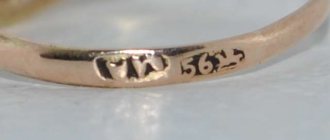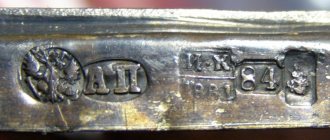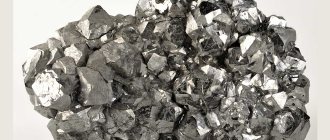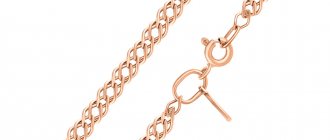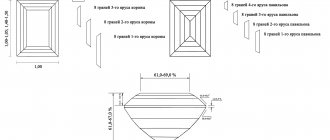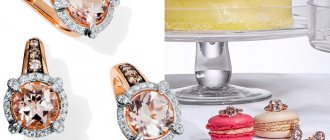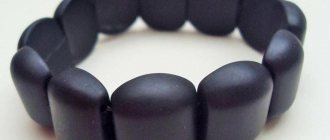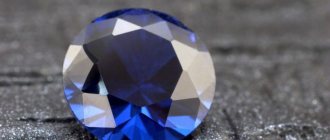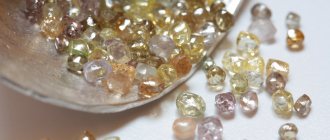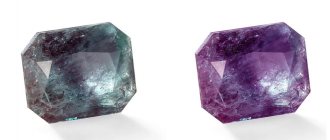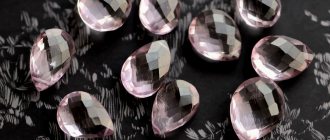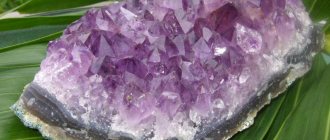Setting is the way in which a gemstone has been “set” into a piece of jewelry. Not only the reliability of fixing the insert depends on the type of setting: it can be used to advantageously present the stone or hide its defects, make the diamond float above the rim or securely wrap it in metal - to protect the beauty during daily wear. We'll tell you all the secrets of setting stones in jewelry!
The model is wearing white gold rings with diamonds 921644-1B, mesh ring 921657B, patterned ring with diamonds 921652-2B and engagement ring 921643B. The cost of each is in the link.
Prong setting
In this type of setting, the stone is held in place thanks to special hooks called prongs. They are located at the same distance from each other and hold the stone as if it were in a basket.
With prong setting, the emphasis is on the stone, and the jewelry itself is secondary. This is an ideal setting for diamond engagement rings. The sun's rays hit the stone from all sides, are reflected from it and attract attention.
Remember! In the word “krapan” and its derivatives, the stress falls only on the first syllable. This applies to both singular and plural. You can’t say “krapana”, you can’t say “krapana”. It is only correct to use the word “krapana”.
A guide to types of jewelry settings. Pros and cons of different types of setting.
August 20, 2022, 16:04 Dmitry Tataurov
Before you buy a ring with a diamond or any other precious stone, you need to decide on the type of setting.
The selected parameter is very important, since it determines how securely the stone will stay in the ring, how long it will not fall out, how the stone looks in a particular setting, and how easy it will be to clean the ring and stones and care for the product while wearing it.
Let's see what types of stone settings exist in rings, and also compare their pros and cons. Below are some of the most popular types of stone settings for diamond and colored gemstone rings:
Prong Settings
Prong setting is one of the most popular methods of setting stones in rings. Prongs are basically metal pins of a given shape that hold the stone in place.
This setting is usually made with four or six teeth. There are also designs with eight teeth. The more prongs the better, since a larger number better keeps the stone from falling out of the setting under external influences. A smaller amount makes the setting comparatively less safe from stone falling out, however, the diamond or any precious stone is more noticeable in the ring.
Advantages: Prongs engage a small volume of stone and leave most of its surface visible. This is especially important when it comes to diamonds, where their brilliance depends on how much passing light is reflected off their facets.
Disadvantages : The problem with prongs is that they can sometimes get caught on clothing or hair. This usually happens when the legs are worn out or not secured well - in such cases the prongs bend and stick out. To avoid this, you need to check your product quite regularly, every couple of years, for such incidents, and periodically repair and tighten the valves if necessary.
If the owner is going to wear the ring every day, or if he (s) works with his hands or is engaged in vigorous activity, then such a fastening is good if the prongs are as close to the base as possible, and not elongated - then there is a guarantee that such a product will last pretty long.
The Tiffany Setting
The Tiffany setting is a type of prong setting. It has six special teeth designed to enhance the brilliance of the diamond and achieve maximum light output.
This option was created by Tiffany &Co. and cannot be reproduced by any other company as the type of setting itself is trademarked. However, many jewelers offer options that have similar designs.
Advantages and disadvantages: the pros and cons of this type of setting are almost the same as those described above.
Bezel Settings
Blind setting is one of the popular designs. This type of setting involves attaching a diamond or any precious stone with a strip of metal that seems to wrap around the stone.
There are two types of gulkha or, as it is also called, rim bartack - full blind bartack and partial rim bartack.
- A full blind setting surrounds the entire stone, all the way around. This type of setting is the most secure, but it also hides a significant portion of the stone.
- Partial blind setting hides the entire stone in a circle - it leaves its sides visible. The parts of the stone that are not secured by the bezel are exposed to potential hazards, drops, and impacts that can cause damage to the stone, but the majority of the diamond or gemstone remains visible compared to the solid part.
Advantages : blind setting provides significantly greater security compared to prong setting. The stone is well protected and less likely to get damaged when worn.
Disadvantages : Blind setting hides more stone compared to prong setting. So if you are buying a ring, for example with a diamond, you must decide what is more important: safety or visibility of the stone. As you can see, there is a trade-off between these two features.
Solitaire Setting
Another type of setting is called Solitaire, in which the center of attention is the stone. This type of setting is one of the most popular as it highlights the winning features of the diamond or gemstone set in the ring.
In the Solitaire setting, the production of prongs is often used. There are also many varieties of Solitaire using rims.
Advantages : Solitaire setting is aimed at focusing the accent on one stone installed in the product. No other additional stones are installed. A ring with such a setting is simple and easy to clean and wash.
Disadvantages : While there are no side stones to draw attention away from the main stone, the lack of additional stones means giving up the opportunity to enhance the sparkle and play of the center stone. And smaller stones cost less for the same total carat weight - for example, a 0.50 ct center diamond with two 0.25 ct on either side (1.00 ct total) will cost less than one 1.00 CT diamond of the same quality.
A ring with a Solitaire setting will have additional pros and cons compared to other types of settings including prong, blind, or any other setting. You can read about this in the relevant sections of this article related to the relevant type of bartack for more information.
Tension Setting
Spring setting means that the stone (diamond or any other) is held in the setting due to the pressure between the two parts of the ring. This pressure is the key point in this setting, and the very name of this type of setting comes from the method itself - using pressure.
For each specific product, this moment of tension (pressure) is worked out so that it corresponds to the size of the stone being fixed, with the help of which the stone will be held.
Advantages : products using spring fastening look great, unique and unusual. This setting provides fairly good visibility of the set stones.
Disadvantages : a good and safe spring setting is quite complex and relatively expensive, since the jeweler goes through a complex process of precisely fitting two strips of metal in the product exactly to the size of the stone being fixed.
Classic spring setting is less secure than conventional blind or prong setting, so the owner of the piece must be careful not to damage the stone, especially if the work involves manual labor. Changing a ring size or setting a new stone into a piece can be difficult and sometimes impossible.
Some of the disadvantages of the classic spring fastening are solved by its modified version - a stylized spring fastening. The point is that from the outside, the modification looks like a typical spring setting, but the stone is held in a rim or claws, which are soldered on both sides of the metal strips of the ring. This type of fastening is safer than the classic spring fastening.
Three - Stone Setting _
The three stone style setting is very popular. The most often used scheme is a large stone in the center, and two smaller ones on the sides, sometimes of the same size. This style of setting is a great choice when creating a diamond ring for special occasions such as a wedding or engagement.
Stones can be secured using prong, blind or any other setting. Read about the pros and cons of each of these types of setting in the relevant sections above.
Benefits : Additional side stones in a three-stone setting increase the brilliance and sparkle of the ring and enhance the play of the center stone, especially if that stone is a diamond.
Disadvantages : The more stones in a piece, the more maintenance and cleaning the piece requires, so the three-stone setting requires special attention when it comes to caring for the piece. Also, if you want the center stone to stand out the most in your ring, make sure that the side stones do not overshadow the center stone in size, shine or color.
V- prong setting (Cathedral Setting)
A special feature of the v-prong setting, also popularly called cathedral setting, is that the stone is mounted high above the shank of the ring. The diamond, as in the photo, is held in place by metal arches, hence the name of this type of setting.
In this setting, the center stone is usually secured with prongs or a band.
This type of setting is one of the most popular. Many people prefer rings with this type of setting for engagement or as wedding rings.
Advantages : Setting the stone higher than the body of the ring (above the shank) adds emphasis to the stone, and arches create the illusion of size and make the set stones appear much larger than they actually are.
Disadvantages : placing the center stone higher than the shank makes it more vulnerable to possible accidental impacts, especially if the owner works a lot with his hands. Also, the height of the ring makes it inconvenient in terms of the fact that it can get caught on clothes or other objects.
Any additional advantages or disadvantages depend on how the center stone is secured - with teeth, a metal band, or some other method.
Halo Settings
This type of setting looks like this: a central stone is set surrounded by a halo of small stones. You can purchase a piece with a single halo or a double halo - the first has only one circle of stones surrounding the central stone, while the double has two circles.
Benefits : Halo setting can significantly increase the overall brilliance of a diamond ring. This setting is a good option if the stone is small and you want to enhance its appearance. Using a halo of small stones can also be a cheaper alternative to buying a large center stone, for example - a 0.70 carat diamond surrounded by smaller diamonds that weigh a total of 0.30 carats will be cheaper than a single 1 carat diamond, all else being equal. characteristics. This depends on the fact that larger stones are rarer and significantly more expensive.
Disadvantages : this type of stone setting is somewhat more difficult to maintain and clean compared to settings that use fewer stones.
Cluster Setting
Cluster setting is the use of a stone setting technique where the stones are set very close to each other, creating the appearance of one large stone made up of smaller stones grouped together. This is somewhat similar to a halo setting.
Cluster setting involves setting a large central stone surrounded by a cluster of smaller stones of the same size.
Advantages : Cluster setting is a good choice if you can't afford a larger center diamond, but want more sparkle and play of light at a lower cost. A variation of the cluster setting, where all the diamonds are the same size, can also create the illusion of one large diamond.
Disadvantages : As with the classic halo tack, the main disadvantage of the cluster tack is that it requires more effort and attention to care for the product.
Channel setting - rail setting (Channel Setting)
Channel setting involves setting the stones into a groove, or channel, in the band of the ring. These stones are smaller in size and usually serve as a complement to the larger center stone, which is usually set using a different type of setting, such as a blind or prong setting. There are also rings that have a single channel, without a center stone.
This is a very impressive type of setting stones in jewelry. Most often used to strengthen small stones. First, a channel or rail is made from precious metal, and then stones are carefully placed into it one after another. They can be located both along the entire circumference of the ring, and in some separate part of it. The metal is usually soldered at the ends of the channel. Smooth seams and careful processing create a very beautiful visual effect - the ring looks solid and harmonious.
Advantages : Channel-set stones are safer and well protected from accidental impacts or chips. This type of bartack does not have protruding parts such as pins or hooks that could get caught on clothing, hair, or other objects.
Disadvantages : channel setting is difficult to clean and maintain, because the places around and under the stones are very difficult to reach. Channel-set rings are also difficult to resize because the resizing process can ruin the channel - which is why it is sometimes impossible to resize such a ring without damaging the channel.
Bar setting between plates - a type of channel setting (Bar Setting)
The stones in this setting are placed in a row and separated by small metal plates. This setting resembles a channel setting in appearance and is a variation of it, although they differ in their structure.
The essence of the fastening: the metal plates protrude slightly above the level of the stones, but the fastening itself occurs as in a channel. Only in this case it is very short - one stone. A popular setting for rings with three or five diamonds. It’s beautiful, but not very reliable in the general case, because there is no sealing, as in the case of channel tack.
A bar-to-plate setting, sometimes called a panel setting, is designed to set small stones that can be accentuated by a large center stone or no stone (a recent popular design for engagement rings).
Advantages : panel setting provides slightly better visibility of the stones in the product compared to channel setting. The bartack itself is relatively safe.
Disadvantages : Although this type of setting is generally safe, it is inferior to channel setting, which provides better protection for stones. Resizing a panel set ring can be a complicated process.
Pave setting - corner setting (Pave Setting)
A pavé setting (pronounced 'pavei' - from the French word for 'paved') is made with very small diamonds set into tiny holes drilled into the ring. The stones are held securely in place by small droplets of metal located between the diamonds. The result is a surface strewn with small stones, which can be fixed even on the most extreme and “impossible” areas of the product, for example on prongs.
There is a variation of this type of setting called “micro-pave”, this subtype of setting uses much smaller diamonds than those used in a regular pavé setting.
Advantages : Paves setting creates a stunning optical effect and incredible brilliance of diamonds in the ring, amazing the imagination. The Pavé setting style is a good choice if you have a stone that is lacking in color and luster and want to enhance its optical properties with brighter, but smaller stones.
Disadvantages : some craftsmen do not know how to set pavé so well that the stones in the product are securely fastened, and not everywhere the stones can be secured with prongs, and in some cases they may not be provided at all.
That's why you should take a close look at your pavé-set ring with a magnifying glass and check for bent or uneven prongs, stones, or stones that could fall out or become dislodged. In pavé set rings it is very nearly impossible to resize if the setting goes all the way around the ring.
Built-in Flush Settings
An inline setting, also called a gypsy setting, is so named because the stone is set flush into the band of the ring. The stone is fixed in a hole specially made in the body of the ring, and the stone, in turn, fits perfectly into this “socket”.
Advantages : The stone is well protected, so this type of setting is a good option for people who lead an active lifestyle and work with their hands. The risk of damage or loss of stone is minimized due to the robust construction.
Disadvantages : Flush setting limits the visible portion of the stone, and therefore can reduce the shine of the stone since it is only visible from above.
Invisible Settings
In invisible setting, stones are set into metal structures hidden under the stones. The result is that these seats (nests) in which the stones are planted are not visible.
Advantages : The invisible setting looks beautiful and it also ensures that the gemstones are well protected from damage as the stones do not stick out from the setting and are therefore less likely to get caught by the stone setting on clothing or other objects.
Disadvantages : although the invisible setting, as a rule, reliably protects the stones from damage, nevertheless, the invisible structures holding the stones can be deformed from a strong blow and the stones can fall out.
Additionally, many invisible-set stones are held in place by cutting small grooves into their pavilion (the lower part of the gemstone's body), into which parts of the invisible-setting metal structure are then inserted. These grooves can reduce the value of the stones if you want to resell them simply as stones without a setting in the future (though if you don't plan to do this, it doesn't matter).
Last but not least, most of the surface of the stones in the invisible setting is not visible, because they are hidden in the setting. This happens because the light passing through the visible surface of the stone is reflected less and therefore produces less shine compared to, for example, a prong setting.
When purchasing a ring with an invisible setting, make sure the stones are securely set and be careful when wearing it (as with any item).
Vintage Setting “ Antique Setting ”
Vintage (antique) setting was intended and was developed for products and elements of products that characterize a certain period in the history of the past.
For example, Art Deco rings have elements inspired by the Art Deco style that was popular from the 1920s to the 1940s. Other common styles of vintage "antique" rings include Victorian, Art Nouveau and Georgian.
Vintage-style settings often include small grain relief (also known as “fine grain”), which is generally done with small beads of metal along the edges of the ring.
Another type of antique setting style design is filigree. Filigree rings were decorated with small metal threads and wires to give the jewelry an antique look.
Based on source materials: https://www.jewelrynotes.com
Authors of the translation: Alexey Tuev and Dmitry Tataurov.
All news
Pavé setting
The name is derived from the English word pave, but without inheriting the phonetic part. Pave in English means "to strew".
Pavé setting is the setting of a large number of stones next to each other. It seems that the jewelry is literally studded with precious stones. Inserts can be located either at the level of the borders of the decoration or protrude beyond it.
Pavé is one of the most difficult types of setting, which is entrusted only to professionals with extensive experience.
Channel
The channel technique is mainly used for small crystals. Recesses are made in the frame into which the inserts are placed. They can be placed in a separate part of the product or along its circumference. The peculiarity of the method is that all seams are processed so that the surface of the product remains smooth , and therefore the ring appears mirror-like. Minerals and precious metal create one whole.
Due to this type of treatment, this type of fastening is very comfortable to wear, the jewelry will not cling to things or hair, and the insert itself is protected from falling out and damage. The downside is the same: the ring size can no longer be changed. Due to the specific treatment, it is difficult to clean the spaces between the stones from dirt.
Adhesive setting
Essential for pearls and other round stones. With this type of setting, the insert is tightly glued to the pin with a special substance that holds the stone very firmly and for a long time. This setting requires care and precision from the jeweler: the pin must fit tightly into the mounting hole, otherwise the stone may fall out.
This setting will give the product an airy effect - it seems that the stone floats as if by magic.
Rare types of fastening
In addition to the main types of fastenings that are used everywhere, there are also those that are extremely rare. For example, a type of prong fastening is carmesine. It is used when you need to create a composition from a large stone in the middle and small ones around it. This is a rather complex method of fixing minerals, requiring the creation of many holes, cutting out a special plate for the main stone and cutting out additional teeth for fastening.
Another method of fastening is invisible. The stone is fixed in special metal plates. They are not visible visually, because... they are hidden by the insert itself. When set in this way, the stone does not cling, but not all of it is visible, but only partially.
Casting with stones - a revolution in the world of inlaying
This is a technology in which metal in a molten state is combined with a precious stone. As a result, the insert holds as firmly as possible in the modern world.
The product can contain one or several stones.
The AQUAMARINE company was one of the first in Russia to master the method of casting with stones.
Corner
The root technique is complex and therefore requires a highly qualified jeweler. With this type of fastening, the crystal is placed directly into gold or silver, in which a hole is made. The holes can be made so that the gems create a pattern on the metal. Thanks to this technique, the effect of beautiful radiance and play of light . The fastening is convenient, allowing you to merge stones and metal into one harmonious whole. However, the technique has a disadvantage , like Pavé's: the size of the ring cannot be changed.
Summarize
- Setting is a method of fixing a precious, semi-precious or artificial stone in a setting.
- With blind setting, the stone is installed inside a metal frame.
- Prong setting is the fastening of a stone with small hooks located at the same distance from each other.
- Pavé setting is the setting of a large number of stones next to each other.
- With corner setting, the stones look as if they are “implanted” into the product itself.
- Rail setting is the installation of several stones in a special cutout inside the product itself.
- When setting with adhesive, the stone is firmly glued into the product with a special stable mixture.
- Casting with stones is considered a revolutionary method in the field of setting. In this case, the stone is attached to the metal in a molten state.
It cannot be said that one type of setting is more durable than another. A good manufacturer's technical control department operates at the highest level. AQUAMARINE's Quality Control Department does not release products that are likely to be defective - we guarantee the quality of each piece of jewelry.
Now you know how inserts can be inlaid into a product. If you meet an inexperienced sales manager in a jewelry store, then determine the type of setting and its properties yourself.
In the following material you will learn about old and modern artistic techniques. See photos of precious metal processing and understand what effort it takes to create a beautiful piece of jewelry.
Stay tuned for our next material. He'll be here soon!
General principles and rules for work
The process of attaching precious inserts to jewelry is a responsible undertaking that requires good physical strength, perseverance and precision from the master. All work is done entirely by hand. To do this they use various tools:
- calipers;
- jewelry vice;
- thermal paste;
- drill.
To set the stones you will need a caliper.
First, the stones are carefully inspected for defects. The product is prepared with a seat using a drill. Next, in the case of prong setting, the “legs” are adjusted. Pebbles are inserted into them and clamped well. It is important not to press too hard when clamping, otherwise the insert may simply crack, and if you do not press too hard, the mineral will wobble or even fall out.
The best
The largest diamond ever found and cut is the Golden Jubilee Diamond. Its weight, just imagine, is 545.67 carats. Found in 1985, it lost relatively little weight during cutting. This stone was given to the King of Thailand for his 50th birthday, hence the name. Now it is set into the ruler's scepter.
Today, the title of the largest ruby on Earth belongs to an as yet unnamed beauty found in northern Greenland. Its leadership is undeniable, because its weight is 440 carats, and even after cutting, according to rough estimates, it will decrease to only 380 carats. While the Rosser Reeves ruby was considered the largest ruby up to this time, with its weight of 138 carats it seems quite miniature compared to the find.
But the largest sapphire can unconditionally be called the “Millennium Sapphire”; its weight reaches 61,500 carats. A unique stone was found on the island of Madagascar. Italian artist Alessioe Boschi engraved the faces of 134 great personalities on it, including Shakespeare, Einstein, Beethoven, Martin Luther King Jr. This unique monument to human genius is estimated at $180 million. But the Jewel of the Jungle sapphire is considered by jewelers all over the world to be the only example of an ideal, pure, deep blue color among all sapphires.
The largest emerald was involved in litigation. The largest piece of emerald, called Bahia, was found in Brazil. It consists of a huge number of emerald crystals encased in rock. Its weight is 1.9 million carats, the estimated value is from 400-900 million dollars. The legal battle over ownership of the stones is considered one of the largest property rights lawsuits in California history. 8 people claim their rights to a wonderful mineral.
